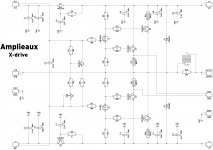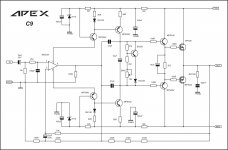X-drive OPS
A-la Bryston output stage with lateral FET drivers and MT-200 output devices (although, 3281/1302 will also work here).
With MT-200 ones and +/-65V rails it will drive 200W @ 8 ohm easily.
Not really a new configuration - Lazy Cat used it long time ago.
I did not live-tested it yet, however simulations look very promising.
Cheers,
Valery
A-la Bryston output stage with lateral FET drivers and MT-200 output devices (although, 3281/1302 will also work here).
With MT-200 ones and +/-65V rails it will drive 200W @ 8 ohm easily.
Not really a new configuration - Lazy Cat used it long time ago.
I did not live-tested it yet, however simulations look very promising.
Cheers,
Valery
Attachments
jwilhelm:
Thanks for your comprehensive reply.
VERY much appreciated!
🙂
mlloyd1
Thanks for your comprehensive reply.
VERY much appreciated!
🙂
mlloyd1
-Start with a good sharp drill bit. Turn it slow and don't make heat. ...
Sauberkeit-LT (light version) - 100W of precision
Hi All,
I decided to make a rather compact and relatively simple DIY-friendly 100W version of the amplifier, based on slightly simplified topology of top-performance Sauberkeit front-end.
I'm not a big fan of the OpAmps in power amplifiers, however - there are always exceptions for a good reason 😉
I'm sure it will be possible to squeeze a single layer PCB into 100x100mm square with just one pair of MT-200 outputs. 2 pairs of 3281/1302 may be used as well, different drivers, like MJE15032/33, are also an option.
It also simulates nicely with HexFET OPS from VHex series - 2 pairs of IRFP240/9240 with KSC3503/A1382 as the drivers.
Key advantages of the topology - low distortion and high - 250...280V/uS - slew rate (depending on particular devices used as the drivers and outputs).
Note multiple feedback loops, current-driven VAS and some other cool nuances.
I will try to come up with my version of the layout, however any other versions are welcome (Marc? 🙂)...
Cheers,
Valery
P.S. It takes the best things from both CFA and VFA "worlds" in combination 😎
Hi All,
I decided to make a rather compact and relatively simple DIY-friendly 100W version of the amplifier, based on slightly simplified topology of top-performance Sauberkeit front-end.
I'm not a big fan of the OpAmps in power amplifiers, however - there are always exceptions for a good reason 😉
I'm sure it will be possible to squeeze a single layer PCB into 100x100mm square with just one pair of MT-200 outputs. 2 pairs of 3281/1302 may be used as well, different drivers, like MJE15032/33, are also an option.
It also simulates nicely with HexFET OPS from VHex series - 2 pairs of IRFP240/9240 with KSC3503/A1382 as the drivers.
Key advantages of the topology - low distortion and high - 250...280V/uS - slew rate (depending on particular devices used as the drivers and outputs).
Note multiple feedback loops, current-driven VAS and some other cool nuances.
I will try to come up with my version of the layout, however any other versions are welcome (Marc? 🙂)...
Cheers,
Valery
P.S. It takes the best things from both CFA and VFA "worlds" in combination 😎
Attachments
-
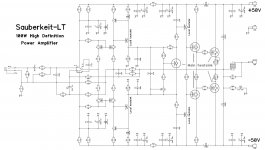 01 Sauberkeit-LT Sch 01.JPG160.4 KB · Views: 568
01 Sauberkeit-LT Sch 01.JPG160.4 KB · Views: 568 -
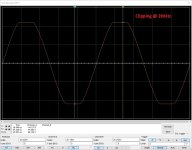 02 Sauberkeit-LT Clipping 20KHz.JPG172.7 KB · Views: 554
02 Sauberkeit-LT Clipping 20KHz.JPG172.7 KB · Views: 554 -
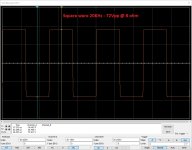 03 Sauberkeit-LT Square 20KHz.JPG174.8 KB · Views: 464
03 Sauberkeit-LT Square 20KHz.JPG174.8 KB · Views: 464 -
 04 Sauberkeit-LT Square 100KHz.JPG178.6 KB · Views: 471
04 Sauberkeit-LT Square 100KHz.JPG178.6 KB · Views: 471 -
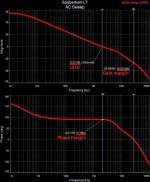 05 Sauberkeit-LT Square NFB.JPG308 KB · Views: 206
05 Sauberkeit-LT Square NFB.JPG308 KB · Views: 206 -
Sauberkeit-LT_Sch_01.pdf59.7 KB · Views: 181
Last edited:
Hi Valery,
For a long time now I have been meaning to build the Mark Alexander CFA design from years ago. I bought the parts, I got as far as designing it, just need to fab and test it out.
Find attached my version of it, done to fit 100x100mm pcb. Let me know what you think?
Cheers
Rick
For a long time now I have been meaning to build the Mark Alexander CFA design from years ago. I bought the parts, I got as far as designing it, just need to fab and test it out.
Find attached my version of it, done to fit 100x100mm pcb. Let me know what you think?
Cheers
Rick
Attachments
Valery;
Thanks for sharing. Have you looked at the" op amp driving grounded source mosfets" approach?
mlloyd1
[
Thanks for sharing. Have you looked at the" op amp driving grounded source mosfets" approach?
mlloyd1
[
Hi All,
....
I'm not a big fan of the OpAmps in power amplifiers, however - there are always exceptions for a good reason 😉
....
Valery
...
Hi Valery,
For a long time now I have been meaning to build the Mark Alexander CFA design from years ago. I bought the parts, I got as far as designing it, just need to fab and test it out.
Find attached my version of it, done to fit 100x100mm pcb. Let me know what you think?
Cheers
Rick
Hi Rick,
I like the overall layout, having one concern though - this kind of board width is fine for 1 pair of the output devices, with 2 pairs it looks somewhat "busy". On the other hand, if the heatsink is good and you're not going to drive those FETs to the limit - it's going to be ok.
Please let me know how it goes - interesting project.
Cheers,
Valery
stocktrader200
NFB goes dirrectly to the triode, it is a very simple input board as I like simple stuff.
Valery
I am using PZTA42 and PZTA92 (1,5W MPSA transistors). They are doing decent job in VAS stage. I have made a lot of input stages and as from the users feedback the ones with MPSA transistors are getting very good reputation.
I see in Sauberkeit You have splitted NFB as in A9 amplifier, I do not know if You have soldered it together or it is just as a project but I bet it will be great sounding amp!!
I have tried good few op-amps in my A9 version and the best sonic results are with OPA2134. Another trick is just balance the ratio in between two NFB loops and give it a good listening session, worth of trying!!
Regards
Peter
NFB goes dirrectly to the triode, it is a very simple input board as I like simple stuff.
Valery
I am using PZTA42 and PZTA92 (1,5W MPSA transistors). They are doing decent job in VAS stage. I have made a lot of input stages and as from the users feedback the ones with MPSA transistors are getting very good reputation.
I see in Sauberkeit You have splitted NFB as in A9 amplifier, I do not know if You have soldered it together or it is just as a project but I bet it will be great sounding amp!!
I have tried good few op-amps in my A9 version and the best sonic results are with OPA2134. Another trick is just balance the ratio in between two NFB loops and give it a good listening session, worth of trying!!
Regards
Peter
Valery;
Thanks for sharing. Have you looked at the" op amp driving grounded source mosfets" approach?
mlloyd1
[
Hi Mlloyd1 - yes, I looked at those common source configurations, allowing OPS with gain. However, up till now, I achieve the best results (in terms of distortion) with the "follower" kind of OPS. Experimenting with feed-forward error correction these days - I believe, in combination with well-designed moderate NFB - this is the way to achieve outstanding results - better quality than class A can offer 😉
Cheers,
Valery
stocktrader200
NFB goes dirrectly to the triode, it is a very simple input board as I like simple stuff.
Valery
I am using PZTA42 and PZTA92 (1,5W MPSA transistors). They are doing decent job in VAS stage. I have made a lot of input stages and as from the users feedback the ones with MPSA transistors are getting very good reputation.
I see in Sauberkeit You have splitted NFB as in A9 amplifier, I do not know if You have soldered it together or it is just as a project but I bet it will be great sounding amp!!
I have tried good few op-amps in my A9 version and the best sonic results are with OPA2134. Another trick is just balance the ratio in between two NFB loops and give it a good listening session, worth of trying!!
Regards
Peter
Hi Peter,
Thank you - good to know about those PZT versions.
Yes - you're looking right into the root idea of this front-end - split NFB loops 😉
OPA627 is also a great device - rather expensive though.
AD744 is used here primarily for wide bandwidth and high slew rate, however - worth trying other options 😎
Cheers,
Valery
Hi Rick,
I like the overall layout, having one concern though - this kind of board width is fine for 1 pair of the output devices, with 2 pairs it looks somewhat "busy". On the other hand, if the heatsink is good and you're not going to drive those FETs to the limit - it's going to be ok.
Please let me know how it goes - interesting project.
Cheers,
Valery
This is roughly what I have in mind with regards to the space between the outputs and corresponding board proportions - assuming all outputs are located on one side of the board) - this is a "Honey budger" board by Ostripper.
One pair - it would look like a square, two pairs - almost twice as wide, etc 😉
Attachments
stocktrader200
NFB goes dirrectly to the triode, it is a very simple input board as I like simple stuff.
Valery
I am using PZTA42 and PZTA92 (1,5W MPSA transistors). They are doing decent job in VAS stage. I have made a lot of input stages and as from the users feedback the ones with MPSA transistors are getting very good reputation.
I see in Sauberkeit You have splitted NFB as in A9 amplifier, I do not know if You have soldered it together or it is just as a project but I bet it will be great sounding amp!!
I have tried good few op-amps in my A9 version and the best sonic results are with OPA2134. Another trick is just balance the ratio in between two NFB loops and give it a good listening session, worth of trying!!
Regards
Peter
There is C9 if you like simple stuff
Regards
Attachments
Thanks Mile, You bet I will try it. Maybe I will just change the current mirror, just in case of use a differed OP-amp I can balance the VAS current. The less components the better.
Regards
Peter
Regards
Peter
Sauberkeit-LT layouts, including etching-friendly version
Hi All,
I have finally done the layouts for both IPS and OPS modules (TH).
Both boards are 99mm x 99mm, Gerbers for the board house and PDFs for etching are included.
Our compact control boards can be used for soft-start and protection - see my signature below.
Let me know if you will have questions.
Cheers,
Valery
Hi All,
I have finally done the layouts for both IPS and OPS modules (TH).
Both boards are 99mm x 99mm, Gerbers for the board house and PDFs for etching are included.
Our compact control boards can be used for soft-start and protection - see my signature below.
Let me know if you will have questions.
Cheers,
Valery
Attachments
-
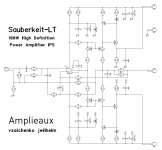 01-01-Sauberkeit-LT-IPS-Sch.JPG104 KB · Views: 642
01-01-Sauberkeit-LT-IPS-Sch.JPG104 KB · Views: 642 -
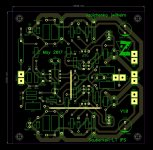 02-01-Sauberkeit-LT-IPS-View.JPG161.8 KB · Views: 628
02-01-Sauberkeit-LT-IPS-View.JPG161.8 KB · Views: 628 -
02-Sauberkeit-LT-03-IPS-etching.pdf178.3 KB · Views: 198
-
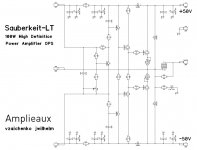 03-01-Sauberkeit-LT-OPS-Sch.JPG101.8 KB · Views: 613
03-01-Sauberkeit-LT-OPS-Sch.JPG101.8 KB · Views: 613 -
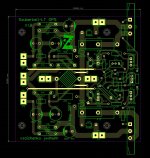 04-01-Sauberkeit-LT-OPS-View.JPG162.9 KB · Views: 614
04-01-Sauberkeit-LT-OPS-View.JPG162.9 KB · Views: 614 -
04-Sauberkeit-LT-03-OPS-etching.pdf171.3 KB · Views: 181
-
Sauberkeit-LT-IPS-Gerber.zip44.9 KB · Views: 125
-
Sauberkeit-LT-OPS-Gerber.zip52.3 KB · Views: 122
Hi,
has someone tested the Lichtstark IPS
(http://www.diyaudio.com/forums/soli...-old-ideas-1970s-ips-ops-193.html#post5049265)
in real live and has made measurements, or is this design discarded because ot the newer IPS Sauberkeit.
has someone tested the Lichtstark IPS
(http://www.diyaudio.com/forums/soli...-old-ideas-1970s-ips-ops-193.html#post5049265)
in real live and has made measurements, or is this design discarded because ot the newer IPS Sauberkeit.
R29 seems unusually high @ 100r.
How did you arrive at this value?
Hi Andrew,
You're right - the optimum value is around 10-15R - used to compensate possible VAS current fluctuation. I took the spreader from one of my previous designs without too much thinking about it.
Although it will work as is, the values, closer to optimum: R29 = 10R, R28 = 4.7k
Hi,
has someone tested the Lichtstark IPS
(http://www.diyaudio.com/forums/soli...-old-ideas-1970s-ips-ops-193.html#post5049265)
in real live and has made measurements, or is this design discarded because ot the newer IPS Sauberkeit.
I've got Lichtstark-X VHex series boards and Lichtstark input boards for the NS series amplifiers waiting for testing. A set of these input boards is about to travel to Greece for Thimios to test as well.
Last edited:
Hi,
has someone tested the Lichtstark IPS
(http://www.diyaudio.com/forums/soli...-old-ideas-1970s-ips-ops-193.html#post5049265)
in real live and has made measurements, or is this design discarded because ot the newer IPS Sauberkeit.
Hi Ampi,
Andrewlebon has tested it live - see POST #2011,
although he did not publish any measurements. He also indicated some issue with under-biasing, most likely related to particular build - I tried to investigate the reason, but have not got reply from Andrew.
Lichtstark and Sauberkeit both utilize current-driven VAS, however they are different in terms of overall topology and feedback arrangement. I wouldn't say one of them is better than the other - it's a matter of personal taste, however both of them are high-precision, low-noise and low-distortion ones.
Lichtstark, being super-linear, provides roughly 2x lower distortion throughout the audio band, however Sauberkeit shows 2x higher slew rate and utilizes multiple feedback loops.
It would be interesting to run a blind listening test between the two - I would not discard one of them. Both are very promising 😉
Cheers,
Valery
They are welcome!🙂I've got Lichtstark-X VHex series boards and Lichtstark input boards for the NS series amplifiers waiting for testing. A set of these input boards is about to travel to Greece for Thimios to test as well.
Hi Ampi,
Andrewlebon has tested it live - see POST #2011,
although he did not publish any measurements. He also indicated some issue with under-biasing, most likely related to particular build - I tried to investigate the reason, but have not got reply from Andrew.
Lichtstark and Sauberkeit both utilize current-driven VAS, however they are different in terms of overall topology and feedback arrangement. I wouldn't say one of them is better than the other - it's a matter of personal taste, however both of them are high-precision, low-noise and low-distortion ones.
Lichtstark, being super-linear, provides roughly 2x lower distortion throughout the audio band, however Sauberkeit shows 2x higher slew rate and utilizes multiple feedback loops.
It would be interesting to run a blind listening test between the two - I would not discard one of them. Both are very promising 😉
Cheers,
Valery
Nice to hear that things are in progress.
Are you designing the circuits with lt-spice?
Chris
- Home
- Amplifiers
- Solid State
- Revisiting some "old" ideas from 1970's - IPS, OPS
